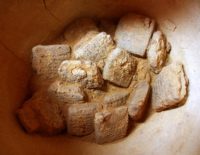 Archaeologists have unearthed a cache of 93 cuneiform tablets at the ancient city of Bassetki in Kurdistan. Most of them, 60, were discovered in a ceramic pot stashed in a room of a structure from the Middle Assyrian period. It and two other vessels had been wrapped in a protective coating of clay, which was providence because the building itself was long-since destroyed. It might even have been a deliberate choice spurred by the tablets themselves.
Archaeologists have unearthed a cache of 93 cuneiform tablets at the ancient city of Bassetki in Kurdistan. Most of them, 60, were discovered in a ceramic pot stashed in a room of a structure from the Middle Assyrian period. It and two other vessels had been wrapped in a protective coating of clay, which was providence because the building itself was long-since destroyed. It might even have been a deliberate choice spurred by the tablets themselves.
“The vessels may have been hidden this way shortly after the surrounding building was destroyed. Perhaps the information inside it was meant to be protected and preserved for posterity,” [dig leader] Professor [Peter] Pfälzner said.
“It is not yet known if the tablets contain business, legal, or religious records.”
“Our philologist, Dr. Betina Faist, deciphered one small fragment of a clay tablet. It mentions a temple to the goddess Gula, suggesting that we may be looking at a religious context.”
“I hope the texts will yield a wide variety of detail about the history, society, and culture of this little-researched area of northern Mesopotamia in the second millennium BC,” he added.
A team from the Institute for Ancient Near Eastern Studies (IANES) at the University of Tübingen has been excavating the site near the town of Dohuk in the autonomous providence of Kurdistan, northern Iraq, since 2013. It was a statue fragment looted during from the Iraqi National Museum in 2003 during the chaotic period after the US invasion that tipped archaeologists off to Bassetki’s potential significance. The statue in question was a cast copper base with human legs and lower body of a naked man which had been discovered in 1975 near the modern-day village of Bassetki. Even though the top of it is missing, it is still incredibly heavy at 150 kg (330 lb) and an inscription on the base tells of Akkadian king Naram-Sin (2254–2218 B.C.), grandson of Sargon the Great, first ruler of the Akkadian Empire. It recounts his successful suppression of a revolt, his elevation to the godhead by the residents of Akkad city and their construction of a temple to him in the city center.
The statue, the only ancient object known to have been found in the Bassetki area, was later recovered by US troops who found it hidden in a cesspool behind the house of antiquities dealers suspected of trafficking in looted artifacts which they obviously were. The rediscovery of the enormously significant piece piqued the interest of Professor Peter Pfälzner who, in collaboration with the Directorate of Antiquities in Dohuk, began to excavate Bassetki with the IANES team. They found that today’s sleepy little village was preceeded by a bustling settlement that was founded around 3000 B.C. and thrived for at least 1200 years after that. As early as 2700 B.C. a defensive wall protecting the upper city from would-be marauders was already standing. The team also found large stone structures dating to around 1800 B.C. and Assyrian cuneiform tablet fragments from around 1300 B.C. Translations of the tablet remains, as much as they were possible, revealed there had once been a temple to the weather god Adad at Bassetki.
 Geomagnetic surveys also discovered a smattering of ruins outside the ancient downtown. There was a lower town about a half mile long, a complex network of roads, multiple residential neighborhoods, expensive and expansive homes of the wealthy and a monumental building of some sort dating to the Bronze Age. The town was hopping in its day, located on a highway dating to around 1800 B.C. that connected it to Mesopotamia and facilitated extensive trade. The whole time they were doing this work, by the way, they were less than 30 miles from ISIS-controlled territory. Archaeology ain’t for the lily-livered.
Geomagnetic surveys also discovered a smattering of ruins outside the ancient downtown. There was a lower town about a half mile long, a complex network of roads, multiple residential neighborhoods, expensive and expansive homes of the wealthy and a monumental building of some sort dating to the Bronze Age. The town was hopping in its day, located on a highway dating to around 1800 B.C. that connected it to Mesopotamia and facilitated extensive trade. The whole time they were doing this work, by the way, they were less than 30 miles from ISIS-controlled territory. Archaeology ain’t for the lily-livered.
“Our finds provide evidence that this early urban center in northern Mesopotamia was settled almost continuously from approximately 3000 to 600 BC,” Professor Pfälzner said.
“That indicates that Bassetki was of key significance on important trade routes.”
Most of the 93 recently-discovered cuneiform tablets were unfired, which always makes them a conservation and translation headache. They are brittle and easily worn by simple erosive elements. Their preservation challenges only increased when the building burned down around them. Researchers will study them with the latest and greatest equipment in the hope of being able to read at least part of the texts.